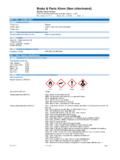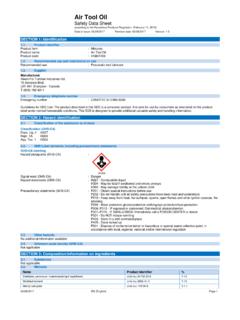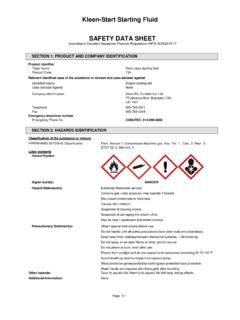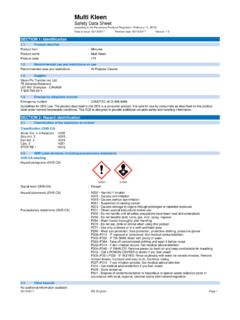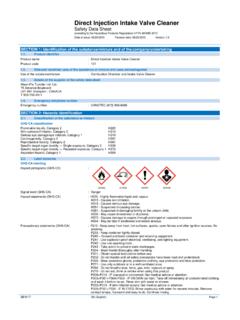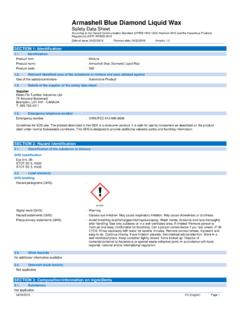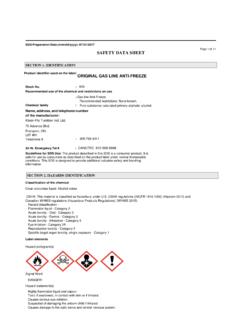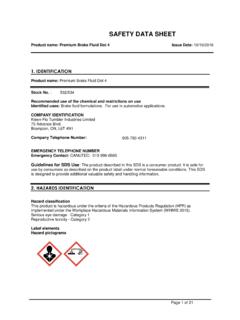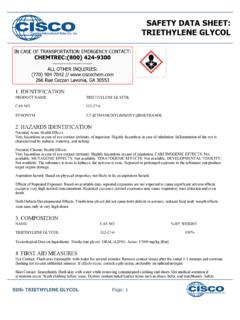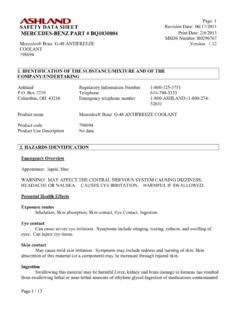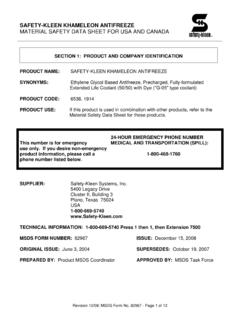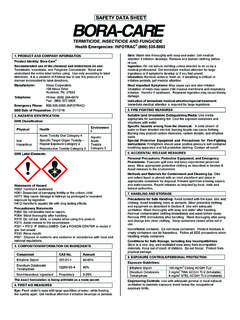Transcription of SAFETY DATA SHEET - Kleen-Flo
1 SAFETY data SHEET Product name: Brake Fluid Dot 3 Issue Date: 10/11/2016 1. IDENTIFICATION Product name: Brake Fluid Dot 3 Stock No.: 525/527/527B/528/529/530 Recommended use of the chemical and restrictions on use Identified uses: A brake fluid - For use in automotive applications. COMPANY IDENTIFICATION Kleen-Flo TUMBLER INDUSTRIES LTD. 75 ADVANCE BLVD. BRAMPTON, ON L6T 4N1 Company Telephone Number: 905-793-4311 EMERGENCY TELEPHONE NUMBER 24-Hour Emergency Contact: CANUTEC: 613-996-6666 2. HAZARDS IDENTIFICATION Hazard classification This product is hazardous under the criteria of the Hazardous Products Regulation (HPR) as implemented under the Workplace Hazardous Materials Information System (WHMIS 2015). Reproductive toxicity - Category 2 Specific target organ toxicity - repeated exposure - Category 2 - Oral Label elements Hazard pictograms Page 1 of 27 Product name: Brake Fluid Dot 3 Issue Date: 10/11/2016 Page 2 of 27 Signal word: WARNING!
2 Hazards Suspected of damaging fertility or the unborn child. May cause damage to organs (Kidney) through prolonged or repeated exposure if swallowed. Precautionary statements Prevention Obtain special instructions before use. Do not handle until all SAFETY precautions have been read and understood. Do not breathe dust/ fume/ gas/ mist/ vapours/ spray. Wear protective gloves/ protective clothing/ eye protection/ face protection. Response IF exposed or concerned: Get medical advice/ attention. Storage Store locked up. Disposal Dispose of contents/ container to an approved waste disposal plant. Other hazards No data available 3. COMPOSITION/INFORMATION ON INGREDIENTS Chemical nature: Polyglycol This product is a mixture. Component CASRN Concentration Polyethylene glycol monomethyl ether 9004-74-4 > - < % Triethylene glycol monoethyl ether 112-50-5 > - < % Triethylene glycol monobutyl ether 143-22-6 > - < % Triethylene glycol monomethyl ether 112-35-6 > - < % Pentaethylene glycol 4792-15-8 < % Tetraethylene glycol 112-60-7 > - < % Polyethylene glycol monobutyl ether 9004-77-7 > - < % Product name: Brake Fluid Dot 3 Issue Date: 10/11/2016 Page 3 of 27 Triethylene glycol 112-27-6 > - < % Diethylene glycol monobutyl ether 112-34-5 < % Diethylene glycol 111-46-6 < % Tetraethylene glycol monoethyl ether 5650-20-4 < % Polyethylene glycol 25322-68-3 < % Diisopropanolamine 110-97-4 < % Diethylene glycol monomethyl ether 111-77-3 < % Di-t-butyl-p-cresol 128-37-0 < % Sodium hydroxide 1310-73-2 < % 4.
3 FIRST AID MEASURES Description of first aid measures General advice: First Aid responders should pay attention to self-protection and use the recommended protective clothing (chemical resistant gloves, splash protection). If potential for exposure exists refer to Section 8 for specific personal protective equipment. Inhalation: Move person to fresh air; if effects occur, consult a physician. Skin contact: Wash off with plenty of water. Eye contact: Flush eyes thoroughly with water for several minutes. Remove contact lenses after the initial 1-2 minutes and continue flushing for several additional minutes. If effects occur, consult a physician, preferably an ophthalmologist. Ingestion: Do not induce vomiting. Seek medical attention immediately. If person is fully conscious give 1 cup or 8 ounces (240 ml) of water. If medical advice is delayed and if an adult has swallowed several ounces of chemical, then give 3-4 ounces (1/3-1/2 Cup) (90-120 ml) of hard liquor such as 80 proof whiskey.
4 For children, give proportionally less liquor at a dose of ounce (1 1/2 tsp.) (8 ml) liquor for each 10 pounds of body weight, or 2 ml per kg body weight [ , ounce (2 1/3 tbsp.) for a 40 pound child or 36 ml for an 18 kg child]. Most important symptoms and effects, both acute and delayed: Aside from the information found under Description of first aid measures (above) and Indication of immediate medical attention and special treatment needed (below), any additional important symptoms and effects are described in Section 11: Toxicology Information. Indication of any immediate medical attention and special treatment needed Product name: Brake Fluid Dot 3 Issue Date: 10/11/2016 Page 4 of 27 Notes to physician: Due to structural analogy and clinical data , this material may have a mechanism of intoxication similar to ethylene glycol . On that basis, treatment similar to ethylene glycol intoxication may be of benefit. In cases where several ounces (60 - 100 ml) have been ingested, consider the use of ethanol and hemodialysis in the treatment.
5 Consult standard literature for details of treatment. If ethanol is used, a therapeutically effective blood concentration in the range of 100 - 150 mg/dl may be achieved by a rapid loading dose followed by a continuous intravenous infusion. Consult standard literature for details of treatment. 4-Methyl pyrazole (Antizol ) is an effective blocker of alcohol dehydrogenase and should be used in the treatment of ethylene glycol (EG), di- or triethylene glycol (DEG, TEG), ethylene glycol butyl ether (EGBE), or methanol intoxication if available. Fomepizole protocol (Brent, J. et al., New England Journal of Medicine, Feb. 8, 2001, 344:6, p. 424-9): loading dose 15 mg/kg intravenously, follow by bolus dose of 10 mg/kg every 12 hours; after 48 hours, increase bolus dose to 15 mg/kg every 12 hours. Continue fomepizole until serum methanol, EG, DEG, TEG or EGBE are undetectable. The signs and symptoms of poisoning include anion gap metabolic acidosis, CNS depression, renal tubular injury, and possible late stage cranial nerve involvement.
6 Respiratory symptoms, including pulmonary edema, may be delayed. Persons receiving significant exposure should be observed 24-48 hours for signs of respiratory distress. In severe poisoning, respiratory support with mechanical ventilation and positive end expiratory pressure may be required. Maintain adequate ventilation and oxygenation of the patient. If lavage is performed, suggest endotracheal and/or esophageal control. Danger from lung aspiration must be weighed against toxicity when considering emptying the stomach. Treatment of exposure should be directed at the control of symptoms and the clinical condition of the patient. 5. FIREFIGHTING MEASURES Suitable extinguishing media: Water fog or fine spray. Dry chemical fire extinguishers. Carbon dioxide fire extinguishers. Foam. Alcohol resistant foams (ATC type) are preferred. General purpose synthetic foams (including AFFF) or protein foams may function, but will be less effective. Unsuitable extinguishing media: Do not use direct water stream.
7 May spread fire. Special hazards arising from the substance or mixture Hazardous combustion products: During a fire, smoke may contain the original material in addition to combustion products of varying composition which may be toxic and/or irritating. Combustion products may include and are not limited to: Carbon monoxide. Carbon dioxide. Combustion products may include trace amounts of: Nitrogen oxides. Unusual Fire and Explosion Hazards: Container may rupture from gas generation in a fire situation. Violent steam generation or eruption may occur upon application of direct water stream to hot liquids. Advice for firefighters Fire Fighting Procedures: Keep people away. Isolate fire and deny unnecessary entry. Use water spray to cool fire exposed containers and fire affected zone until fire is out and danger of reignition has passed. Fight fire from protected location or safe distance. Consider the use of unmanned hose holders or monitor nozzles. Immediately withdraw all personnel from the area in case of rising sound from venting SAFETY device or discoloration of the container.
8 Burning liquids may be extinguished by dilution with water. Do not use direct water stream. May spread fire. Move container from fire area if this is possible without hazard. Burning liquids may be moved by flushing with water to protect personnel and minimize property damage. Special protective equipment for firefighters: Wear positive-pressure self-contained breathing apparatus (SCBA) and protective fire fighting clothing (includes fire fighting helmet, coat, trousers, boots, and gloves). If protective equipment is not available or not used, fight fire from a protected location or safe distance. Product name: Brake Fluid Dot 3 Issue Date: 10/11/2016 Page 5 of 27 6. ACCIDENTAL RELEASE MEASURES Personal precautions, protective equipment and emergency procedures: Isolate area. Keep unnecessary and unprotected personnel from entering the area. Refer to section 7, Handling, for additional precautionary measures. Use appropriate SAFETY equipment. For additional information, refer to Section 8, Exposure Controls and Personal Protection.
9 Environmental precautions: Spills or discharge to natural waterways is likely to kill aquatic organisms. Prevent from entering into soil, ditches, sewers, waterways and/or groundwater. See Section 12, Ecological Information. Methods and materials for containment and cleaning up: Small spills: Absorb with materials such as: Sand. Vermiculite. Collect in suitable and properly labeled containers. Large spills: Contain spilled material if possible. Pump into suitable and properly labeled containers. See Section 13, Disposal Considerations, for additional information. 7. HANDLING AND STORAGE Precautions for safe handling: Do not swallow. Avoid contact with eyes. Wash thoroughly after handling. Spills of these organic materials on hot fibrous insulations may lead to lowering of the autoignition temperatures possibly resulting in spontaneous combustion. See Section 8, EXPOSURE CONTROLS AND PERSONAL PROTECTION. Conditions for safe storage: Store in the following material(s): Carbon steel.
10 Stainless steel. Phenolic lined steel drums. Do not store in: Aluminum. Copper. Galvanized iron. Galvanized steel. Storage stability Storage temperature: 5 - 35 C 8. EXPOSURE CONTROLS/PERSONAL PROTECTION Control parameters Exposure limits are listed below, if they exist. Component Regulation Type of listing Value/Notation Triethylene glycol Dow IHG TWA Total 100 mg/m3 Diethylene glycol monobutyl ether ACGIH TWA Inhalable fraction and vapor 10 ppm Dow IHG TWA 35 ppm Diethylene glycol US WEEL TWA 10 mg/m3 Polyethylene glycol US WEEL TWA aerosol 10 mg/m3 Diisopropanolamine Dow IHG TWA 10 ppm Diethylene glycol monomethyl ether Dow IHG TWA 10 ppm Dow IHG TWA SKIN Di-t-butyl-p-cresol ACGIH TWA Inhalable fraction and vapor 2 mg/m3 CA AB OEL TWA 10 mg/m3 Product name: Brake Fluid Dot 3 Issue Date: 10/11/2016 Page 6 of 27 CA BC OEL TWA Inhalable vapour and aerosols 2 mg/m3 CA QC OEL TWAEV 10 mg/m3 Sodium hydroxide ACGIH C 2 mg/m3 CA AB OEL (c) 2 mg/m3 CA BC OEL C 2 mg/m3 CA QC OEL C 2 mg/m3 Consult local authorities for recommended exposure limits.
